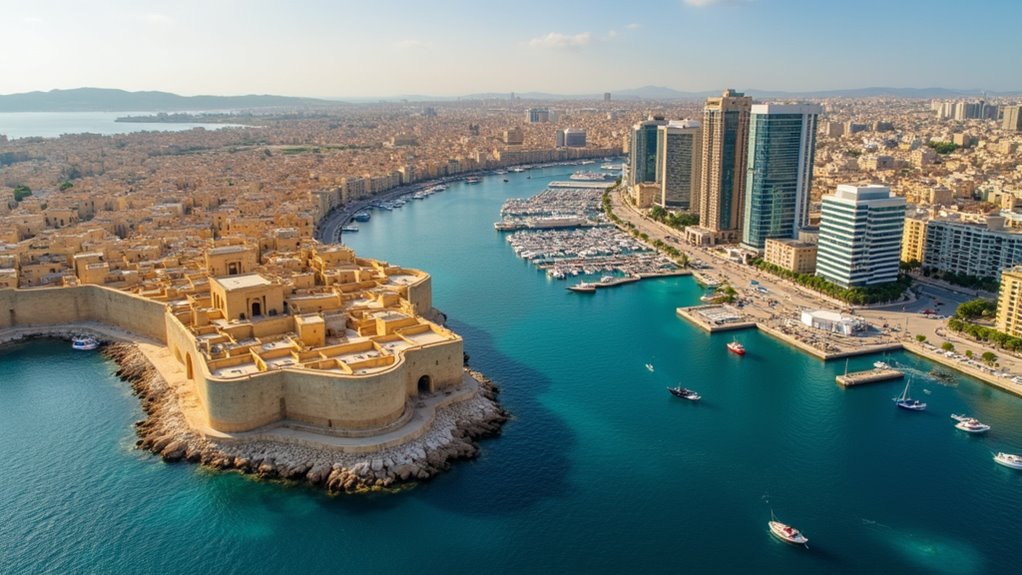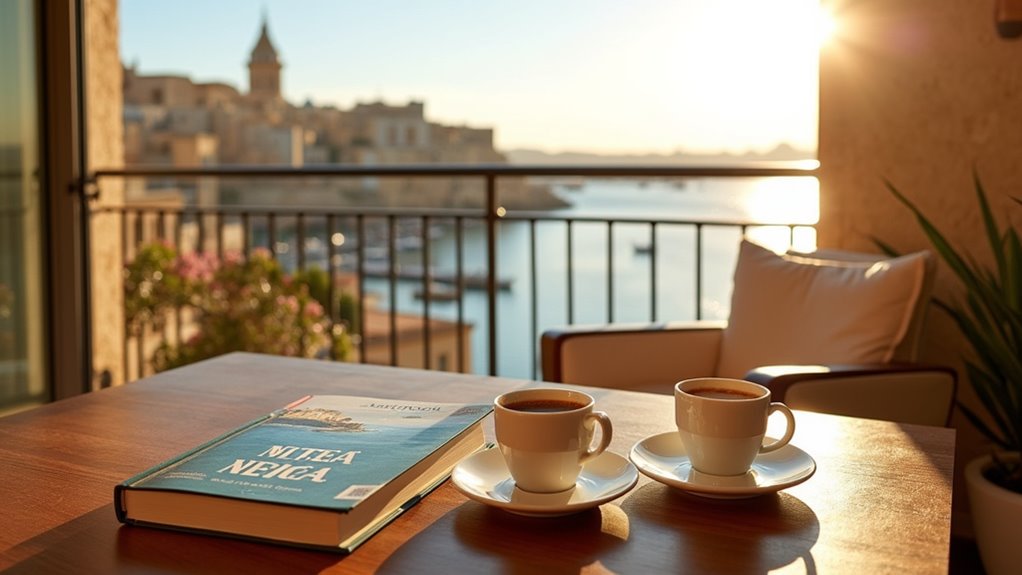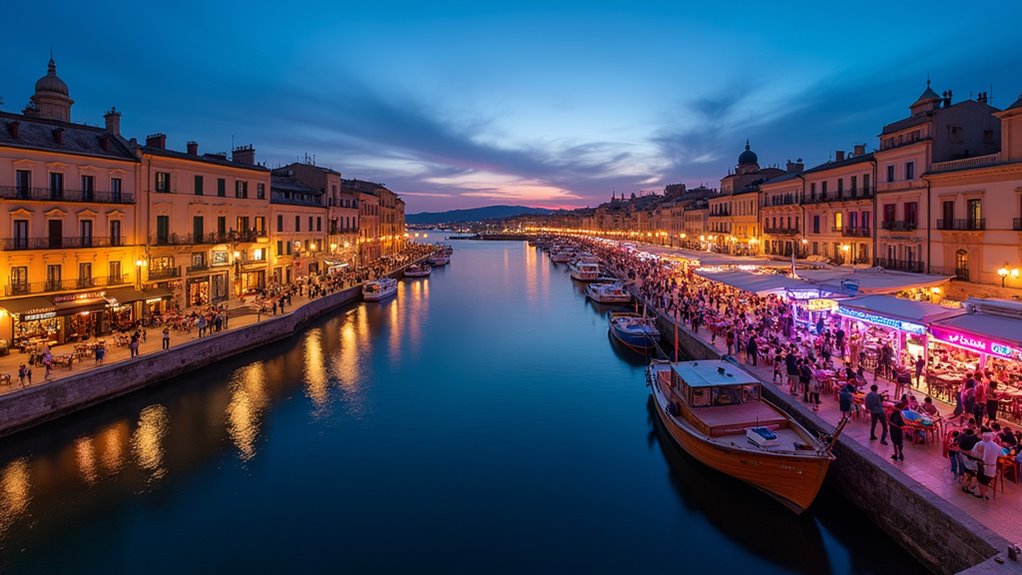Physical Address
304 North Cardinal St.
Dorchester Center, MA 02124
Physical Address
304 North Cardinal St.
Dorchester Center, MA 02124

Undecided between Valletta's historic charm and Sliema's modern convenience? Discover which Maltese destination perfectly matches your travel style.
Valletta offers historic charm with UNESCO-listed architecture and cultural opulence but steeper streets and higher accommodation prices. Sliema provides modern amenities, better waterfront access, and cheaper hotels with a livelier nightlife scene. Choose Valletta for immersive history and traditional Maltese atmosphere, or Sliema for contemporary convenience and easier beach access. Your perfect base depends on whether you’re seeking cultural exploration or relaxed coastal living. Let’s explore each location’s unique advantages for your Malta adventure.

When choosing between Valletta and Sliema, you’ll immediately notice their distinct characters despite being just minutes apart. Valletta fascinates with its historic urban environment, narrow streets, and traditional Maltese atmosphere. As Malta’s capital, it’s a cultural hub hosting numerous festivals and events throughout the year.
Sliema, in contrast, presents a more modern face with wider streets, contemporary amenities, and a reputation for shopping and vibrant nightlife. You’ll find immediate beach access here, though primarily rocky rather than sandy shorelines. Much like Split’s coastal charm, Sliema offers visitors a perfect blend of Mediterranean scenery and urban convenience.
While Valletta offers easier access to historical attractions and central bus connections, Sliema delivers faster internet speeds and more diverse dining options. Both areas are safe for travelers, though Sliema scores slightly higher (88.0 vs. 84.0) on safety metrics. Visitors to Sliema will enjoy 100 Mbps internet speeds, perfect for remote workers or those who need reliable connectivity.
While Valletta functions as a living museum to Malta’s storied past, Sliema offers a stark historical contrast despite their proximity. In Valletta, you’ll walk through UNESCO-protected streets where every building tells a story of the Knights of St. John who shaped the city’s distinctive Baroque architecture.
The imposing Fort St. Elmo, pivotal during the Great Siege of 1565, stands alongside the Grandmaster’s Palace and St. John’s Co-Cathedral housing Caravaggio’s masterpieces. Daily cannon fire from the Saluting Battery echoes centuries of maritime tradition. For those seeking a break from historical exploration, Malta’s crystal-clear waters provide excellent snorkeling opportunities similar to those found near Dubrovnik.
Sliema, by comparison, presents a younger historical narrative. Once a quiet fishing village, it transformed during British rule into a fashionable resort town, offering glimpses of Malta’s more recent colonial past through Victorian-era architecture. Visitors can experience Valletta’s rich history through highly recommended walking tours that showcase the city’s limestone fortifications dating back to the 1560s.

Choosing between Valletta and Sliema presents distinct lodging experiences despite their close proximity. In Valletta, you’ll find charming boutique hotels in historic palazzos with smaller rooms, commanding premium rates due to the UNESCO World Heritage setting.
Sliema offers modern high-rises, chain hotels, and more spacious accommodations at approximately 8% lower costs.
Transport considerations may influence your decision: Valletta’s central bus terminus provides island-wide connectivity, while Sliema offers better parking for rental cars and convenient ferry routes.
Valletta’s compact layout eliminates the need for transportation when exploring central attractions.
Both areas see 20-40% price increases during summer months, with better deals available in shoulder seasons (April-May and October).
Winter travelers benefit from significant discounts in both locations, though amenities differ dramatically between Valletta’s historic charm and Sliema’s modern convenience. St. Julian’s area, adjacent to Sliema, provides additional resort-style options for travelers seeking more luxurious accommodations.
The choice ultimately depends on whether you prefer UNESCO heritage surroundings with historical ambiance or contemporary comfort with waterfront views.
Both Valletta and Sliema boast impressive culinary landscapes that satisfy diverse palates and preferences. In Valletta, you’ll find authentic Maltese cuisine at Legligin, where traditional meze and homemade chocolates await. Meanwhile, AKI offers creative Japanese dishes for international cravings. Like Zagreb’s food scene, these areas showcase a vibrant mix of traditional and modern gastronomic experiences.
Sliema counters with Ta’ Kris, serving generous portions of Maltese specialties like rabbit stew in cozy side-street settings. Both areas feature fast food options including McDonald’s and Pizza Hut alongside high-end establishments.
For romantic dining, Rampila in Valletta provides sophisticated Mediterranean cuisine in historic surroundings. Waterfront restaurants in Sliema offer scenic views with your meal.
Nearby Valletta Ferry, highly-rated I PUPI Pizzeria and Gambit Bistro & Bar serve excellent food. Casa Sotto stands out with 4.9 bubble ratings and over 1,500 positive reviews. International options like Hard Rock Cafe provide familiar flavors.

After a satisfying meal, many travelers want to know what the nightlife offers. Valletta and Sliema present distinctly different evening atmospheres that cater to varied preferences.
Valletta transforms into a tranquil haven after dark, with historic venues like The Pub and Bridge Bar offering jazz sessions and intimate wine experiences at Tico-Tico and Legligin. For a cultural twist, some establishments incorporate Turkish food influences in their late-night menus, bringing an international flair to Malta’s capital. Most establishments close relatively early, perfect for those preferring relaxed evenings. The city’s quieter, historic ambiance makes it perfect for couples seeking peaceful evening strolls through beautifully lit streets.
Sliema maintains a livelier vibe with:
You’ll find Valletta ideal for romantic, history-infused evenings while Sliema suits those seeking more energetic social settings and contemporary entertainment options.
Traveling between Valletta and Sliema offers several convenient options that cater to different preferences and schedules. The 6km journey takes just 14 minutes by Line 13 bus (departing every 30 minutes) or 15 minutes by hourly ferry.
For the quickest trip, taxis cover the distance in roughly 8 minutes, though they’re pricier than public transport.
When planning your journeys, consider that rush hour traffic (particularly 5-6pm) can considerably slow road travel. Water options like ferries and water taxis provide scenic harbor views while bypassing congestion. Many travelers prefer using ride-sharing apps like Bolt or GoTaxi for convenient door-to-door service.
Bus tickets cost €2-3 per ride, with transport cards available for frequent travelers. Unlike vacation hotspots such as Portugal or Croatia, Malta’s compact size makes travel between major areas relatively quick.
While Sliema’s promenade is ideal for walking and cycling, Valletta’s steep streets can be challenging on foot. The Barrakka Lift helps reduce walking distances within Valletta’s center.

When comparing beach access between these two neighboring destinations, you’ll find significant differences that might influence your stay. Valletta lacks natural sandy beaches, offering only rocky coastal access, while Sliema features similar rocky shorelines for swimming.
If you’re seeking authentic beach experiences, note that:
The convenient Valletta-Sliema ferry crosses the harbor in just 10 minutes, connecting you to both waterfronts.
Sliema’s flat coastal path makes waterfront exploration easier compared to Valletta’s steep stairs and narrow streets. Many travelers choose Sliema as their base because it offers better all-round access to waterfront activities while maintaining proximity to Valletta’s historical attractions. September offers ideal temperatures for enjoying Malta’s coastal activities without the summer crowds that typically fill Croatian beaches.
Choosing between Valletta and Sliema ultimately depends on your travel preferences and priorities.
History enthusiasts should opt for Valletta with its UNESCO status, Baroque architecture, and museums.
Romantics will appreciate Valletta’s intimate boutique hotels and illuminated evening strolls, though Sliema offers stunning sunset harbor views.
If convenience matters most, Sliema wins with its flat promenade, better airport access, and 24-hour services. Budget-conscious travelers may prefer Sliema for its wider range of affordable dining options along the bustling Tower Road.
Mobility-limited travelers will struggle with Valletta’s hills.
For luxury, Valletta delivers Michelin-starred dining and palatial hotels, while Sliema emphasizes contemporary amenities like infinity pools.
Nightlife seekers should choose Sliema for its lively bars and proximity to St. Julian’s clubs.
Valletta offers a more refined evening scene with wine bars and traditional kantini in a less rowdy atmosphere.
Day-trippers might consider that both locations provide excellent access to must-visit destinations throughout Malta’s historic archipelago.
You’ve now spent more time researching Valletta versus Sliema than you’ll actually spend enjoying either location. The truth? They’re a mere 20-minute ferry ride apart. While you’ve agonized over this life-altering decision, locals are laughing at travelers who can’t decide between two spots they themselves visit in the same day. Just pick one—you’ll see both anyway.